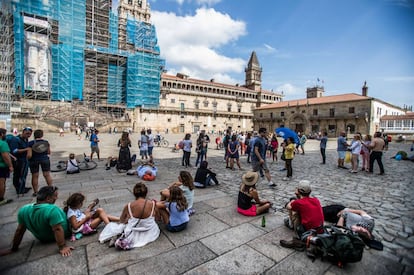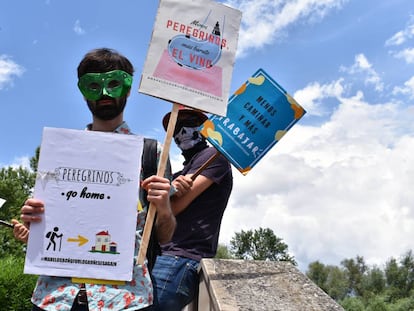“I'm a pilgrim. Will you shout me a drink?”
Number of visitors to pilgrim site of Santiago de Compostela is rising but spending is going down

Just weeks after protesters in the northern Spanish city of Logroño complained about the negative impacts on their city brought about the presence of low-spending pilgrims on Spain’s world-famous Camino de Santiago pilgrimage route, tourism operators further along the grueling trail have expressed their own concerns.

Bar owners in the city of Santiago de Compostela in Spain’s northwestern Galicia region say the city, which is a major pilgrimage site, is full of tourists who are trying to cut costs wherever possible. In some cases, pilgrims on the Camino de Santiago (known in English as the Way of St James) even ask for the drinks to be on the house.
“We want lots of people to come here, but we also want them to spend. The other day I saw a group order one dish for three people,” one bar worker says.
It’s true that the streets are full but the people don’t spend Sara Santos, Santiago Hospitality Association
“It’s true that the streets are full but the people don’t spend. Most people come as part of a bus trip and get handed a sandwich [by their tour operators] in a plastic bag when they arrive,” says Sara Santos with the Santiago Hospitality Association.
Official figures back up the complaints from the hospitality sector. The average sum spent by tourists in the city that is Galicia’s capital was €51 last year, down from €53 in 2015, according to an annual study carried out by the Cetur tourism institute at the University of Santiago de Compostela. This dip in spending can be seen among both those who stay overnight in the city and those who come on a day trip.
Beyond Spain’s financial crisis, Cetur sees other reasons for the fall in outlay: these include the fact that most tourists who come to the city as pilgrims stay in the very cheap inns set up to cater for them, and the fact that many of the visitors come from other parts of Spain.
But local tourism operators also believe the city is not offering enough information to pilgrims about the diverse range of cultural activities it has to offer. They say such information should be provided along the pilgrimage route as it nears Santiago.
Tourism operators believe the city is not offering pilgrims enough information about cultural activities
“It’s not right that the average length of stay in a city like Santiago, which receives pilgrims and people interested in culture and gastronomy, is one and a half nights,” says Santos.
Meanwhile, the number of tourists visiting the city continues to climb. Some 134,000 people made use of Santiago’s tourism offices in the first seven months of this year, up from 123,000 in 2015. A decade ago that figure was only 111,000.
But the local tourism industry is also keen to avoid the problems associated with mass tourism such as those currently being seen in Barcelona or Mallorca. “Tourism is an economic driver of the city and we have to create a quality model that allows for living in the historic old town without it being converted into a theme park,” said mayor Martiño Noriega recently.
English version by George Mills.
Tu suscripción se está usando en otro dispositivo
¿Quieres añadir otro usuario a tu suscripción?
Si continúas leyendo en este dispositivo, no se podrá leer en el otro.
FlechaTu suscripción se está usando en otro dispositivo y solo puedes acceder a EL PAÍS desde un dispositivo a la vez.
Si quieres compartir tu cuenta, cambia tu suscripción a la modalidad Premium, así podrás añadir otro usuario. Cada uno accederá con su propia cuenta de email, lo que os permitirá personalizar vuestra experiencia en EL PAÍS.
¿Tienes una suscripción de empresa? Accede aquí para contratar más cuentas.
En el caso de no saber quién está usando tu cuenta, te recomendamos cambiar tu contraseña aquí.
Si decides continuar compartiendo tu cuenta, este mensaje se mostrará en tu dispositivo y en el de la otra persona que está usando tu cuenta de forma indefinida, afectando a tu experiencia de lectura. Puedes consultar aquí los términos y condiciones de la suscripción digital.
More information
Archived In
Últimas noticias
Most viewed
- Sinaloa Cartel war is taking its toll on Los Chapitos
- Oona Chaplin: ‘I told James Cameron that I was living in a treehouse and starting a permaculture project with a friend’
- Reinhard Genzel, Nobel laureate in physics: ‘One-minute videos will never give you the truth’
- Why the price of coffee has skyrocketed: from Brazilian plantations to specialty coffee houses
- Silver prices are going crazy: This is what’s fueling the rally










































